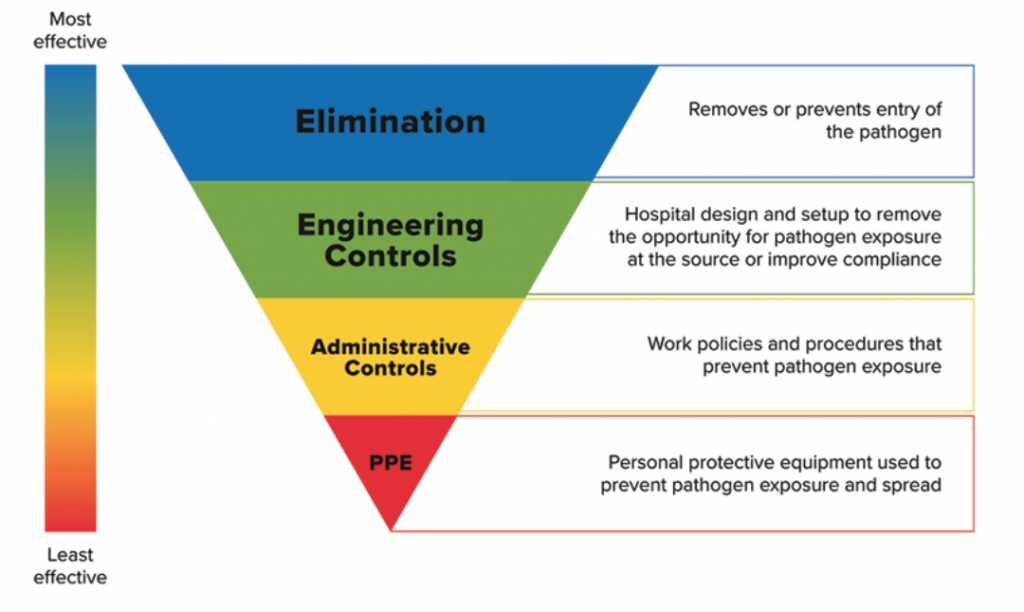Skill Group: Biosafety and Biosecurity
Risk Assessment and Introduction to Personal Protective Equipment (PPE) Part 1
Learning Outcomes
By the end of this lesson, you should be able to:
- Identify hazards in veterinary work
- Classify hazards as physical, radiation, chemical, or biological
- Perform a risk assessment (hazard analysis)
- Apply the hierarchy of controls based on identified risks
- Identify key domains of infection control and how PPE is included.
- Identify the purpose of PPE use.
- Define key infectious disease concepts pertinent to PPE use and selection.
In our work and personal lives, we encounter many hazards (risks) that have the potential to cause injury or illness. Hazards that are most relevant to the veterinary field can be broken into a few categories including physical, chemical, biological, and radiation.
Physical:
These hazards can cause a wide range of injuries. Some examples include animal kicks and bites, scalpel wounds, needlesticks, falls, airborne debris landing in your eye, hearing loss from noise, and repetitive motion injuries.
Radiation:
These hazards from ionizing radiation are technically physical injuries but warrant special attention here. Exposure while performing radiographs or radiation therapy may occur through improper use of personal protective equipment, poorly maintained or malfunctioning equipment, or inclusion of hands in the primary radiation beam (even when wearing protection).
Chemical:
These hazards can cause toxicity or burns. Some examples include inhalation of waste anesthetic gas, or contact with medications or chemicals encountered in the work placed (e.g., spot-on animal pesticides, transdermal medications, and concentrated solutions of disinfectants).
Biological:
These hazards may cause infections in those who are exposed. Examples of these include dermatophytes (ringworm (fungi), Salmonella spp. (bacteria), Rabies (virus), and Cryptosporidium spp. (parasite).
The Occupational Safety and Health Association (OSHA) has regulations that require employers to provide a workplace that does not pose a risk of serious harm. Potential hazards must be identified and shared with employees along with training and appropriate equipment necessary to prevent harm.
Once potential hazards have been identified, a risk assessment (hazard analysis) can help identify methods for eliminating or controlling the hazard in order to prevent illness or injury. Specific activities can be broken down into job tasks to aid in identification of hazards. For each task ask:
What is the task? Eg lancing a large abscess on a dog
What could go wrong? Eg purulent liquid could splash in my eyes
What are the consequences if that happens? Eg eye could be injured or irritated (physical hazard), possible infection (biologic hazard)
How could it happen? Abscess is pierced and expressed under pressure
Are there other contributing factors? Location of piercing on the abscess, contents under pressure, additional pressure applied while immobilizing the abscess
How likely is it that the hazard will occur? It has happened before
This process will allow you to document all physical, radiologic, chemical, and biological hazards associated with a specific task or activity. Once hazards are identified and risk is assessed, potential control measures can be recommended.
Risk control measures are those taken to eliminate or reduce the risk of injury or infection. There are four categories of control measures (hierarchy of control) that can be used, and they can be employed in various combinations. Preference is given to control measures that eliminate or reduce the risk, while personal protective equipment (PPE) is reserved for tasks where other control measures cannot be implemented or do not completely mitigate the risk. Though PPE, which protects the individual from the still present risk, is the last choice, it is essential that it be selected and used with great care and consideration. The four categories (with examples) are:

1. Elimination: remove the hazard from the work place.
- Do not admit a venomous snake unless the facility and staff are properly equipped and trained
- Replace a more toxic disinfectant with a less toxic one
- Ventilate an animal hoarding home to remove ammonia before entering the area
2. Engineering: prevent exposure to the worker.
- Install a radiation barrier near the radiograph machine
- Install a waste anesthetic gas scavenger
- Use double sided runs to house aggressive dogs to reduce the need to handle during routine cleaning and feeding, thereby reducing bites to staff
3. Administrative Controls: changes in human work practices and policies
- Require rabies pre-exposure prophylaxis (vaccination) for all staff
- Assign highest skilled staff to handle aggressive patients
- Rotate staff in animal hoarding response activities so that they spend half of their time indoors catching animals and half of their time outdoors assisting with record-keeping and transporting animals
4. Personal Protective Equipment (PPE): Items worn to protect the individual from the risk that is still present. Eg. gloves, safety eyewear, masks, hearing protection, respirators, boots.
- Require the use of hearing protection in boarding kennel with a high number of barking dogs
- Cover exposed skin (e.g., gloves, gown, etc.) and mucus membranes (googles with face mask or full face shield) when working with a potentially rabid dog
- When capturing animals in an animal hoarding home with elevated ammonia levels and poor air quality, wear a respirator that protects against ammonia and particulates
The 2018 AHAA Infection Control Guidelines contain the figure below describing the hierarchy of controls for biologic hazards. The top tiers are generally considered more effective at minimizing hazards (e.g., pathogen exposure) than the lower tiers. Often, a risk assessment leads to a combination of control measures to effectively reduce exposures.